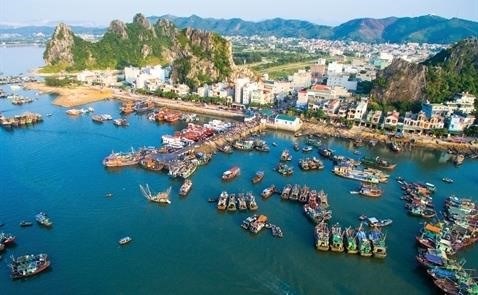The Ministry of Planning and Investment (MPI) sent an express dispatch to ministries to collect ideas on the socio-economic plan for the Van Don Economic Zone by 2030 with a vision to 2050.
The document asked ministries to join a planning evaluation council and quickly submit opinions on the plan to the Prime Minister for approval.
Earlier, the provincial People’s Committee submitted a document to the PM and MPI about the master plan for approval.

Van Don is targeting becoming one of the nicest cities for living in the Asia-Pacific region by 2050 (Photo: cafefland.vn)
According to the plan, the Van Don Economic Zone is targeting becoming a green, smart and modern island urban area with a focus on logistics, high-end tourism and modern entertainment. It will have a casino and a centre for start-ups and international trade in the China-ASEAN economic corridor.
The EZ would have a sustainable social and economic foundation by 2030 under the master plan. It would be a centre of high quality labour and one of the most liveable cities in the Asia-Pacific region by 2050.
Specifically, the EZ would reach Gross Regional Domestic Product (GRDP) of 1.98 billion USD and GRDP per capita of 12,242 USD in 2030, which would be four times higher than the expected level in 2020.
The province said the EZ could create jobs for 106,000 people by 2030, including 37,000 jobs in the tourism sector; 7,000 in service; 14,000 in production and logistics and 48,000 in other sectors.
The Van Don EZ was expected to become one of the most famous cities in the world and a gateway to the northern region of Vietnam. By 2050, the EZ’s GRDP would reach more than 21.8 billion USD and GRDP per capita would be 43,688 USD with a population of 501,000 people.
The master plan also said the EZ would base its growth on three main pillars of tourism, cultural services and innovation and production and logistics. These sectors would contribute 82.1 percent of its total GRDP and 70 percent of its jobs by 2050.
Van Don targets developing high-class eco-tourism. It plans to develop casino entertainment services, 3-5 star hotels, spiritual tourism and marine tourism packages.
In addition, it will develop aviation transportation and logistics to become a logistics hub for the country.
The provincial People’s Committee said it targeted building helipads on Cai Bau, Quan Lan and Thang Loi islands. Meanwhile, it would develop seaport to serve tourism and goods transport.
Under the plan, Van Tien bridge will be built to connect the EZ with the Tien Yen Economic Zone, completing the Ha Long-Mong Cai expressway. A high speed rail will connect the EZ with other regions both inside and outside the country. The EZ will also build a metro line in the 2030-2050 period.
The province will mobilise investment from all economic sectors including the State budget, the private sector and foreign direct investment. It has seen private sector investments from Sun Group, FLC, CEO, MBland, Crystal Bay and HD Mon.
Quang Ninh is offering various incentives and preferential mechanisms to encourage investors to invest in economic zones (EZs), industrial parks (IPs) and border economic zones (BEZs) in the province.
At present, the province has 11 industrial parks, one coastal economic zone (Van Don) and three planned border economic zones, which are located in 11 districts, towns and cities. They cover a total area of more than 368,000 ha, or 30.2 percent of the province’s area.
Doing business in Quang Ninh has become easier in recent years, thanks to local authorities’ efforts to simplify administrative procedures.
The northern coastal province has an automatic customs monitoring system and has digitalised many administrative procedures.
It has simplified procedures related to business registration and construction licensing, reducing time and money for enterprises.
These efforts have helped reduce time of customs clearance for imported goods to only 24 hours instead of 39 hours as previously.
Meanwhile, the time for individuals and organisarions to complete procedures to start business is six days, a cut of three quarters of the time compared with regulations in Government Resolution 19. Meanwhile, the time for granting construction permits is no more than 52 days, 68 days less than regulations in Government Resolution 19.
Thanks to the locality’s efforts to cut time spent processing administrative procedures, the locality’s investment environment has improved remarkably.
In 2018, Quang Ninh granted and adjusted investment licences for 50 projects with total registered capital of more than 23.6 trillion VND (over 1 billion USD)./.